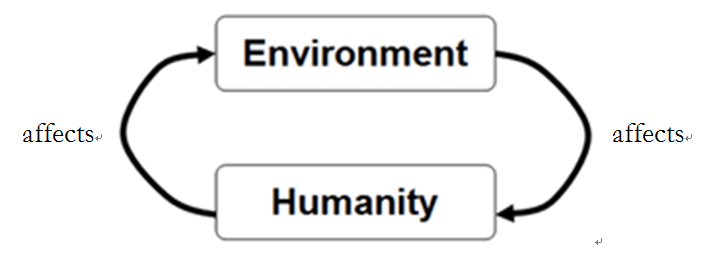What Are Coupled Human-Environment Systems?
As the concept of the human-environment landscape clearly shows, humans impact the environment, and the environment impacts humans. These impacts happen in many different ways. In other words, there are very many interactions between humans and the environment. In order to help us keep track of all these interactions, and to learn from them, it is very useful to use a systems perspective. This means treating humans and the environment as systems: the human system and the environmental system. We could even treat them as one combined human-environment system.
What is a system? In simple terms, it is a collection of components that interact with each other to form some aggregated whole. For example, this course is a system. It has many components, including the modules, the course assignments, the instructor, and the students. These components all interact with each other to form the course. The components can also be thought of as systems. For example, this module has several web pages, some supplemental readings, and a learning activity at the end. Each of these module components can be thought of as a system, too.
To help us visualize and understand systems, it is often helpful to use a systems diagram. A systems diagram displays the system’s components and the interactions between them. In a systems diagram, we put short descriptive phrases (not sentences) in boxes to represent the components that make up the system. Interactions between the components are often symbolized by arrows pointing in a logical direction. Sometimes we also place single words or short phrases along the arrows to explain the nature of these interactions.
Here is an oversimplified systems diagram showing a human-environment system in which humans and the environment both impact each other:

The systems diagram above is far too simple to illustrate how humans and the environment interact with each other. Let’s take a closer look at the concept of human-environment systems. This concept is developed very well in Gerry Marten’s online textbook Human Ecology. This textbook has excellent systems diagrams and discussions of other aspects of human-environment systems that could serve as a helpful resource for you if you need it.
Reading Assignment: "What is Human Ecology?"
Here, please read just the first section, “What is Human Ecology?” The second section covers sustainable development, which we’ll return to later.
- Marten, Introduction: What is Human Ecology?
As you’re reading this first section, think about how systems are being used to describe humanity, the environment, and interactions between them. Here are some more questions to think about as you read:
- What, according to this reading, is the relationship between humanity and the environment?
- What are some components of the human system and the environment system? How do these components interact?
- What are the specific examples of human-environment systems being presented? What are the components, and how do they interact?
- If you were given a story about a human-environment system, could you draw a systems diagram for it?
